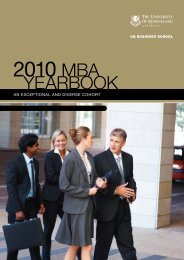Modelling the accruals process and assessing unexpected accruals*
Modelling the accruals process and assessing unexpected accruals*
Modelling the accruals process and assessing unexpected accruals*
You also want an ePaper? Increase the reach of your titles
YUMPU automatically turns print PDFs into web optimized ePapers that Google loves.
4 Assessing <strong>unexpected</strong> <strong>accruals</strong> measures<br />
The identification of earnings management with <strong>the</strong> <strong>unexpected</strong> <strong>accruals</strong> approach critically<br />
depends on <strong>the</strong> ability of <strong>unexpected</strong> <strong>accruals</strong> to capture abnormal <strong>accruals</strong>. With <strong>unexpected</strong><br />
<strong>accruals</strong> being <strong>the</strong> empirical estimates of abnormal <strong>accruals</strong>, <strong>the</strong> bias in <strong>unexpected</strong> <strong>accruals</strong> (i.e.,<br />
<strong>the</strong> difference between <strong>the</strong> two) can be determined by three components – measurement error in<br />
variables, heterogeneity in parameters, <strong>and</strong> omitted variables. Measurement error in variables<br />
arises when accurate measures of accounting variables cannot be obtained. Heterogeneity in<br />
parameters arises when parameters of individual observations differ from <strong>the</strong> regression<br />
parameters, which reflect <strong>the</strong> average effect of <strong>the</strong> parameters of <strong>the</strong> observations involved in <strong>the</strong><br />
regression. Finally, <strong>the</strong> omission of relevant variables can also cause a difference between<br />
abnormal <strong>and</strong> <strong>unexpected</strong> <strong>accruals</strong> because <strong>the</strong>y will be captured by <strong>the</strong> regression disturbance<br />
term. Since measurement errors are unavoidable in accounting variables, I only comment on<br />
<strong>the</strong>m whenever appropriate. Much of my analysis will focus on <strong>the</strong> problems of heterogeneity<br />
<strong>and</strong> omitted variables.<br />
4.1 Encompassing model<br />
To derive a more general model that encompasses <strong>the</strong> Jones model, I divide <strong>the</strong> OIB of short-<br />
term <strong>accruals</strong> in table 3 by revenue of <strong>the</strong> same period <strong>and</strong> divide DA by <strong>the</strong> lagged non-current<br />
operating assets. Re-arranging yields<br />
WC DA REV REV REV<br />
t t u, t1 u, t u, t1<br />
j j 0, t 1, t j 2, t j 3, t j<br />
where <strong>the</strong> parameters are represented as<br />
<br />
u<br />
C C ,<br />
NCO NCO <br />
u, t1 u, t<br />
4, t j 5, t j t, j<br />
<br />
t<br />
a<br />
t<br />
da<br />
u, t1<br />
PM<br />
0, t t t<br />
<br />
1, t TWC TWC<br />
(11)<br />
23



